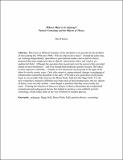Whose Mass is it Anyway? Particle Cosmology and the Objects of Theory
Author(s)
Kaiser, David I.
DownloadKaiser.WhoseMass.pdf (426.6Kb)
PUBLISHER_POLICY
Publisher Policy
Article is made available in accordance with the publisher's policy and may be subject to US copyright law. Please refer to the publisher's site for terms of use.
Terms of use
Metadata
Show full item recordAbstract
Physicists in different branches of the discipline were puzzled by the problem of mass during the 1950s and 1960s: why do objects have mass? Around the same time, yet working independently, specialists in gravitational studies and in particle theory proposed that mass might arise due to objects’ interactions with a new (and as yet undetected) field. Although the questions they posed and even the answers they provided shared several similarities - and even though both proposals quickly became ‘hot topics’ in their respective subfields - virtually no one discussed one proposal in the light of the other for nearly 20 years. Only after massive, unprecedented changes in pedagogical infrastructure rocked the discipline in the early 1970s did a new generation of physicists begin to see possible links between the Brans-Dicke field and the Higgs field. For the new researchers, trained in different ways than most of their predecessors, the two objects of theory were not only similar - some began to proclaim that they were exactly the same. Charting the histories of these two objects of theory illuminates the complicated institutional and pedagogical factors that helped to produce a new subfield, particle cosmology, which today ranks at the very forefront of modern physics.
Date issued
2006-08Department
Massachusetts Institute of Technology. Department of Physics; Massachusetts Institute of Technology. Program in Science, Technology and SocietyJournal
Social Studies of Science
Publisher
Sage Publications
Citation
Kaiser, D. “Whose Mass is it Anyway? Particle Cosmology and the Objects of Theory.” Social Studies of Science 36, no. 4 (August 1, 2006): 533-564.
Version: Author's final manuscript
ISSN
0306-3127